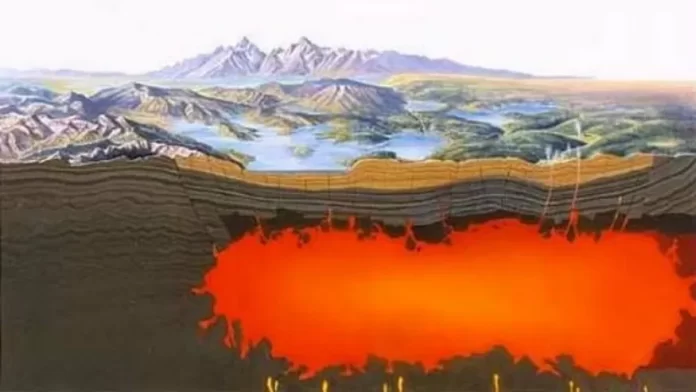Beneath the world-famous geysers and bubbling mud pots of Yellowstone National Park, scientists have uncovered a geological phenomenon that may be playing a silent but vital role in averting disaster: a “breathing” cap of magma located just 3.8 kilometers beneath the Earth’s surface.
This finding, published in the journal Nature, offers a fresh perspective on one of the world’s most closely monitored supervolcanoes. A team of researchers from Rice University, the University of New Mexico, the University of Utah, and the University of Texas at Dallas revealed that this volatile-rich magma cap may be steadily venting gases and pressure — a process that could be preventing the volcanic system from building up the force necessary for a massive eruption.
“This system is behaving almost like it’s breathing,” explained Brandon Schmandt, a geophysicist from Rice University and co-author of the study. “Gases are rising through cracks and narrow spaces between mineral crystals in a consistent, regulated manner.”
Using advanced seismic imaging technology, the scientists deployed a 53,000-pound vibroseis truck — typically used in oil and gas exploration — to generate low-intensity earthquakes. These vibrations allowed the researchers to send seismic waves deep into the Earth and record how they bounced back from different underground layers. The experiment, conducted at night to avoid disruptions from Yellowstone’s heavy daytime activity, involved over 600 seismometers placed across the park.
The data collected revealed the presence of the cap and provided much more precise measurements of its depth. Prior to this, estimates of the magma system’s upper boundary ranged from three to eight kilometers, leaving a large margin of uncertainty about its current state compared to pre-eruption conditions in the past.
Yellowstone sits atop a massive volcanic system that has erupted catastrophically in the distant past — the last major eruption occurring around 640,000 years ago. Since then, the area has remained highly active, with frequent geothermal events and minor earthquakes. However, the discovery of this gas-regulating cap adds an unexpected twist to the volcano’s story.
Scientists now believe that as gases dissolve and rise through the cap, they may be easing the internal pressure that would otherwise accumulate and potentially trigger a violent explosion. In essence, this “breathing” mechanism could be acting as a natural safety valve.
The implications of this discovery are significant, not just for Yellowstone but for our understanding of volcanic systems globally. It suggests that the risk of sudden super-eruptions might, in some cases, be mitigated by internal geological features that allow pressure to be released slowly over time.
Yet, the researchers caution that this does not mean Yellowstone is completely safe. Volcanic systems are dynamic and unpredictable, and while this cap appears to be stabilizing the system now, changes in its composition or structure could alter that balance.
“We’ve opened a new window into the inner workings of Yellowstone,” said Schmandt. “But with volcanoes, we must remain humble. What’s true today might not be true tomorrow.”
This groundbreaking study not only deepens our knowledge of Yellowstone’s inner life but also underscores the value of cutting-edge seismic technology in monitoring and understanding the Earth’s most powerful forces — forces that, for now, appear to be held at bay by a quiet, steady breath beneath the surface.














